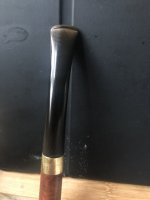Okay, I'm glad you have a technique that works for you, and I have one that works for me.
Repairing a Pitted Stem.
- Thread starter Franco Pipenbeans
- Start date
You are using an out of date browser. It may not display this or other websites correctly.
You should upgrade or use an alternative browser.
You should upgrade or use an alternative browser.
SmokingPipes.com Updates
Watch for Updates Twice a Week
Yeah, looks like the stem was bleached.Okay, I'm sucked into the hellhole vortex of discussing pipe stem oxidation
The oxy bath is fine for badly oxidized stems. I always hate to say this, as there are those who disagree strongly, and as I said in another thread, I'd almost prefer to talk religion (which I hate to discuss!). My preferred soak is the B&A stuff, but it's nastier to deal with and I'd rather soak 6 or so stems at a time. With oxy I can whip up a quick batch for one pipe.
The pitting you are concerned about is probably after an attempt to remove oxidation (that's what it looks like, but I'm only guessing). Remember - the oxidation is the bad stuff that has to go. The good stem material doesn't leave along with it when you soak; however, depending on the quality of the rubber stem (some are much better and denser than others) and the level of oxidation, it may look like good stem material has left (bad pitting). But it hasn't. And the pitting is never horrible after a soak - much of it is oxidation that has loosened and accumulated and now just needs to be scrubbed off. The good stem material is just hiding beneath the gunk.
After the soak, there are, again, many ways to attack what remains of the problem, but start with scrubbing off as much of the bad stuff as you can, by conventional means. If my stem looked as bad as yours, I would certainly then hit it with 600 grit sandpaper, then either begin going through the micromesh progression or start with the less fine of the two B&A polishes.
But as Curly said, "there is more than one way to skin a cat". George Dibos has said the same thing, during a pipe stem restoration discussion - to me, directly, so I know he means it, and I know all of you take his word as gospel (as do I). So...go skin your cat however you wish.
Another old gunsmith’s trick I learned years ago, is that instead of a sharp knife, get one broken piece of glass (a busted picture frame is perfect) and put it in a box and break it into slivers.I use a small, sharp pocket knife, tilted at about a 10 degree angle. I have never lost any briar using it - it tends to ride on the original finish. It doesn't sound intuitive, but it works better than anything I have ever tried.
What you have is a series of different razor sharp edges you can use to cut with. Some will be angled, some curved.
When they dull, throw it away and use another.
Another old gunsmith’s trick I learned years ago, is that instead of a sharp knife, get one broken piece of glass (a busted picture frame is perfect) and put it in a box and break it into slivers.
What you have is a series of different razor sharp edges you can use to cut with. Some will be angled, some curved.
When they dull, throw it away and use another.
Yeah, dullness is a problem. You would think that 'sharp' would mean accidents cutting into the briar, but it just never happens.
Update - I ordered some Savenelli pipe stem polish, some manicure blocks and I set to work with gusto and a happy frame of mind.
Although the pipe stem polish was sold as “for use on all pipe stems” on the website, the jar itself says “for use on ebonite only” - why can’t thinks ever just be simple?
With elbow grease, grim determination and a head full of Covid I have managed to resurrect the above mentioned stem…

It looks like I need to do a bit of touching up around the lip but then I have had a couple of bowls in it to celebrate. When I do that I think I’ve cracked it!
The amount of sulphury brown dust that came off with the manicure block was quite staggering. Good call to use those @Chasing Embers. ??
The only down side? Amazon are now sending me recommendations for ladies beach wear as a result of my manicure block purchases…?
Although the pipe stem polish was sold as “for use on all pipe stems” on the website, the jar itself says “for use on ebonite only” - why can’t thinks ever just be simple?
With elbow grease, grim determination and a head full of Covid I have managed to resurrect the above mentioned stem…

It looks like I need to do a bit of touching up around the lip but then I have had a couple of bowls in it to celebrate. When I do that I think I’ve cracked it!
The amount of sulphury brown dust that came off with the manicure block was quite staggering. Good call to use those @Chasing Embers. ??
The only down side? Amazon are now sending me recommendations for ladies beach wear as a result of my manicure block purchases…?
I agree with our fellow contrarian. No. And rest assured that many others feelI know he means it, and I know all of you take his word as gospel (as do I).
similarly. Nothing personal. Pipe smokes often - not always - are their own people.
I agree with our fellow contrarian. No. And rest assured that many others feel
similarly. Nothing personal. Pipe smokes often - not always - are their own people.
Good.





